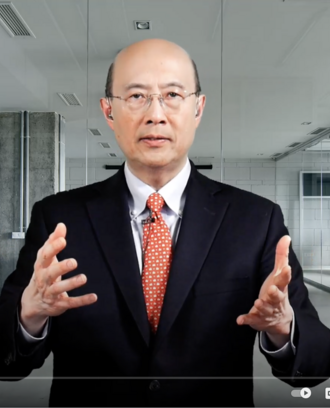Credit: Sean Willems
Higher education in the Age of COVID-19: MIT Sloan visiting professor designs a home video studio for online teaching and learning that approximates the on-campus, in-person experience
By
Professor offers recommendations for how others can recreate the studio for less than $1,000
Cambridge, Mass., September 30, 2020— As college and graduate students return to the virtual classroom this fall, schools around the world are grappling with the same pandemic-era challenge: What’s the best way to improve the quality of remote instruction so that it more closely resembles the magic of the on-campus, in-person learning experience?
The "talking head" station that Sean Willems constructed.
Credit: Sean WillemsIt is a question that once kept Sean P. Willems up at night. This summer Willems, a Visiting Professor of Operations Management at the MIT Sloan School and the Haslam Chair in Supply Chain Analytics at the University of Tennessee, Knoxville, taught a graduate-level global operations class in which he had to both redesign the course for an online format, and figure out how to employ technology to actively engage students—many of whom had never set foot on a business school campus. He now knows a thing or two about the topic.
“There’s some truth to the notion that great teaching transcends the medium,” he says. “But in the Age of COVID-19, when so many of us are living our lives on Zoom, there’s also truth to the idea that the medium matters. As educators, it’s incumbent on us to create virtual environments where students engage with the material and with each other in a manner that fosters critical thinking and shared learning.”
Over the course of 30 days, Prof. Willems converted a room in his home into a video studio for teaching. During that time, he procured a large amount of prosumer equipment—not what a professional video production outfit would use, but much more than what an amateur run-and-gun vlogger might have. He recently wrote a research paper about his experience that is generating interest from faculty at MIT Sloan and beyond.
“My top priority was to enhance the production quality of the standard Zoom meeting to allow for more dynamism and spontaneity,” he says. “In-person teaching cycles between modalities: the instructor walks around the room, poses questions to the class and facilitates group discussion, writes on the whiteboard, and projects applications on a display. But Zoom’s one-dimensional interface is cumbersome and doesn’t allow instructors to smoothly shift teaching modes. In order to make the virtual classroom look and feel like the real thing, that needed to be fixed.
”To that end, Prof. Willems purchased multiple cameras and lenses, which improved the sharpness and quality of the video resolution; a lightboard station—a pane of illuminated glass that enabled students to see him and what he was writing on the whiteboard at the same time; a Stream Deck, which automated the movement between camera stations so that he could move about the room and interact with students, PowerPoints, and spreadsheets, without missing a beat; and an array of other tools and technologies. In particular, he relied on the open source Open Broadcaster Software platform, which served as the command center for the studio and allowed him to switch between teaching modes.
The lightboard station—a pane of illuminated glass that enables students to see the professor and what they are writing on the whiteboard at the same time.
Credit: Sean Willems“The other students and I were blown away from day one,” according to Sravani Yajamanam Kidambi MBA ’22, who took the course this summer. “In my prior online classes, I could only see the professor’s head in a tiny box at the top of the screen. There were often glitches, technical issues, and transitions were clunky. But Prof. Willems’s class moved around seamlessly. With the press of a button, he would ask us questions one minute, then move to a split screen, where we see him and what he was writing, the next. The course had an interactive atmosphere that felt akin to the energy and enthusiasm of the classroom. It helped me feel like I was right there and closer to the MIT community."
While Prof. Willems estimates he spent more than $10,000 on his home studio, his paper offers advice and recommendations for how faculty can furnish their own teach-from-home studios at a fraction of that cost. For instance, a simplified talking-head station—complete with a wireless microphone system, Stream Deck, and plug-and-play document camera—would offer similar functionality and cost less than $1,000.
“The coronavirus has created massive challenges to teaching and learning, and there’s no manual for how to do this perfectly,” says Prof. Willems. “But with the right tools, a little creativity, and effort to reimagine the teaching approach, instructors can translate their teaching style to the online format and deliver classroom experiences like they do on campus.”
About the MIT Sloan School of Management
The MIT Sloan School of Management is where smart, independent leaders come together to solve problems, create new organizations, and improve the world. Learn more at mitsloan.mit.edu.



